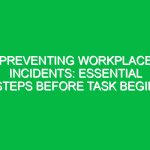Introduction
Slips, trips, and falls (STFs) are among the most common workplace accidents, leading to significant injuries and even fatalities each year. These incidents are not merely unfortunate occurrences; they represent a critical area of concern within the Health, Safety, and Environment (HSE) domain. Understanding how to prevent STFs is essential for employers and employees alike, as these accidents can lead to lost productivity, increased insurance costs, and a potentially unsafe work environment.
In this article, we will explore the intricacies of slips, trips, and falls, examining their causes, impacts, and prevention strategies. By providing actionable tips and insights, we aim to enhance workplace safety and foster an environment where everyone can work without the fear of falling victim to these preventable accidents.
Understanding Slips, Trips, and Falls
Slips occur when there is not enough friction between the foot and the walking surface, causing an individual to lose their balance. Common causes include wet floors, spills, or loose floor coverings. Trips, on the other hand, happen when a person’s foot strikes an object, leading to a loss of balance. This can occur due to uneven surfaces, clutter in walkways, or inadequate lighting. Falls can result from either slips or trips and often lead to serious injuries, particularly among older adults.
In the context of HSE, addressing STFs is paramount. The Health and Safety Executive (HSE) in the UK highlights that slips, trips, and falls account for over a third of all reported injuries in the workplace. This statistic underscores the necessity for effective preventive measures.
Key Factors Contributing to Slips, Trips, and Falls
Environmental Factors
The environment plays a significant role in contributing to STFs. Various conditions can create hazardous situations:
- Wet or Slippery Surfaces: Rain, spills, or cleaning can leave surfaces slick.
- Uneven Flooring: Cracks, holes, or misaligned flooring can create tripping hazards.
- Poor Lighting: Insufficient lighting can obscure obstacles and increase the likelihood of accidents.
- Cluttered Walkways: Items left in pathways can easily cause trips.
Human Factors
Human behavior and decisions also play a vital role in the occurrence of STFs. Factors include:
- Inattention: Distractions can lead to a failure to notice hazards.
- Poor Footwear: Shoes lacking adequate grip or support can increase the risk of slipping.
- Fatigue: Tired employees may be less cautious and more prone to accidents.
Procedural Factors
Insufficient training and lack of safety protocols can exacerbate the risk of STFs. Organizations must ensure that employees understand safety procedures and are aware of potential hazards.
Preventive Measures for Slips, Trips, and Falls
Preventing slips, trips, and falls requires a comprehensive approach involving environmental modifications, training, and continuous vigilance. Here are essential tips to create a safer workplace environment:
1. Conduct Regular Inspections
Regular inspections of the workplace can help identify and mitigate hazards before they lead to accidents. Create a checklist that covers:
- Floor conditions
- Clutter in walkways
- Lighting levels
- Proper signage for wet floors
Scheduling these inspections can be the difference between a safe environment and an accident-prone one.
2. Implement Effective Cleaning Protocols
Maintaining clean floors is crucial in preventing slips. Ensure that:
- Spills are cleaned promptly.
- Floors are regularly mopped and dried.
- Cleaning supplies are appropriately labeled and stored.
Using slip-resistant cleaning products can also minimize the risk of creating slippery surfaces.
3. Ensure Proper Lighting
Good lighting is vital for safety. Ensure that all areas of the workplace are well-lit, particularly:
- Stairways
- Entrances and exits
- Hallways and walkways
Consider installing motion-activated lights in areas that may be used infrequently.
4. Provide Training and Education
All employees should receive training on recognizing and mitigating hazards related to STFs. Topics should include:
- Safe walking practices
- Proper footwear
- Reporting hazards
Regular refresher courses can reinforce these messages and keep safety at the forefront of employees’ minds.
5. Use Proper Signage
Signage is a valuable tool in preventing STFs. Use clear, visible signs to indicate:
- Wet floors
- Hazardous areas
- Uneven surfaces
Signs should be easy to understand and positioned where they will be seen by employees and visitors.
6. Optimize Workplace Layout
Evaluate the layout of the workplace to eliminate potential hazards. Consider:
- Removing obstacles from walkways
- Creating designated walkways
- Ensuring that cables and wires are secured and out of the way
A well-organized workspace can significantly reduce the risk of STFs.
7. Encourage a Safety Culture
Fostering a safety culture within the organization can lead to proactive behavior regarding STFs. Encourage employees to:
- Report potential hazards immediately.
- Participate in safety meetings and discussions.
- Engage in peer-to-peer safety checks.
A culture of vigilance and accountability can make a substantial difference in preventing accidents.
Recognizing the Impact of Regulations and Standards
Understanding the regulations surrounding slips, trips, and falls is essential for compliance and safety. Various standards exist, such as:
- Occupational Safety and Health Administration (OSHA): OSHA provides guidelines for workplace safety, including regulations on walking-working surfaces.
- Health and Safety at Work Act 1974: This UK legislation requires employers to ensure the health and safety of employees.
Compliance with these regulations not only protects employees but also helps organizations avoid legal repercussions and fines.
Real-Life Examples of Slips, Trips, and Falls
Analyzing real-world incidents can provide insights into the importance of preventive measures. For instance, a manufacturing plant in Ohio experienced significant injuries due to a lack of attention to spills. Employees frequently slipped on wet floors, leading to multiple claims and increased insurance costs. After implementing strict cleaning protocols and conducting regular safety training, the facility saw a dramatic decrease in slip-related incidents.
Conversely, a retail store in California faced hefty fines after a customer tripped over a poorly placed display. The incident highlighted the importance of maintaining clear walkways and adhering to safety standards. This case serves as a reminder that both employees and customers are at risk if preventive measures are not taken seriously.
Conclusion
Slips, trips, and falls are not merely statistics; they are serious incidents that can lead to long-lasting implications for individuals and organizations. By understanding the causes and implementing effective preventive measures, we can create safer workplaces for everyone. Regular inspections, effective cleaning protocols, proper training, and fostering a safety culture are just a few of the many strategies that can be employed.
The importance of preventing STFs within the HSE context cannot be overstated. By prioritizing safety, we not only protect employees but also enhance overall productivity and morale. Every workplace should strive to create an environment where slips, trips, and falls are not a daily threat but a rare occurrence. It is our collective responsibility to ensure that safety remains a top priority in every aspect of our work lives.


